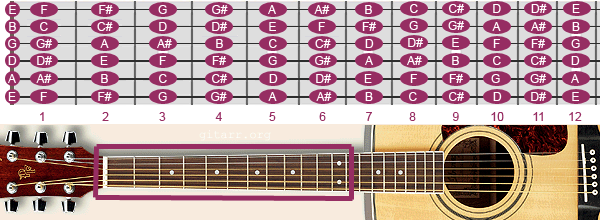Analyzing the Guitar Fretboard
A typical guitar starts with 6 strings, varying in thickness. The thicker the string, the lower the pitch will be. The thicker strings are at the top of the guitar, and gradually get thinner. The higher you play on the fretboard the higher the pitch is going to be. So let's say that you a standard F chord on the first fret. If you move that same chord starting on the 6th fret, it will become a much higher pitched chord.

In standard tuning the 6 strings are in a E,A,D,G,B,E format. As you can tell from the diagram below, going from E to an F and a B to a C is a half-step apart. Meaning it takes a one fret distance to reach between the two. Whereas, going to a G, A, B or D takes a whole step, meaning it takes would require to two fret distance to reach. It is rather important to memorize the fretboard early on (or at least the low E and A string) to help understand the logic behind forming different chord shapes and solos. The reason why knowing the thickest two strings (E and A) is so important is because it helps you distinguish between barre chords (when you finally know how to play them). This is because the root note of the chord is usually found on it's thickest string. So for example, if we take the F chord, the reason why it's called an F is because the root note (thickest string) that your'e playing is found on the first fret on the low E string which is an F note. If we were to move the same chord to the fifth fret, it would be a A major chord instead.


Comments
Post a Comment